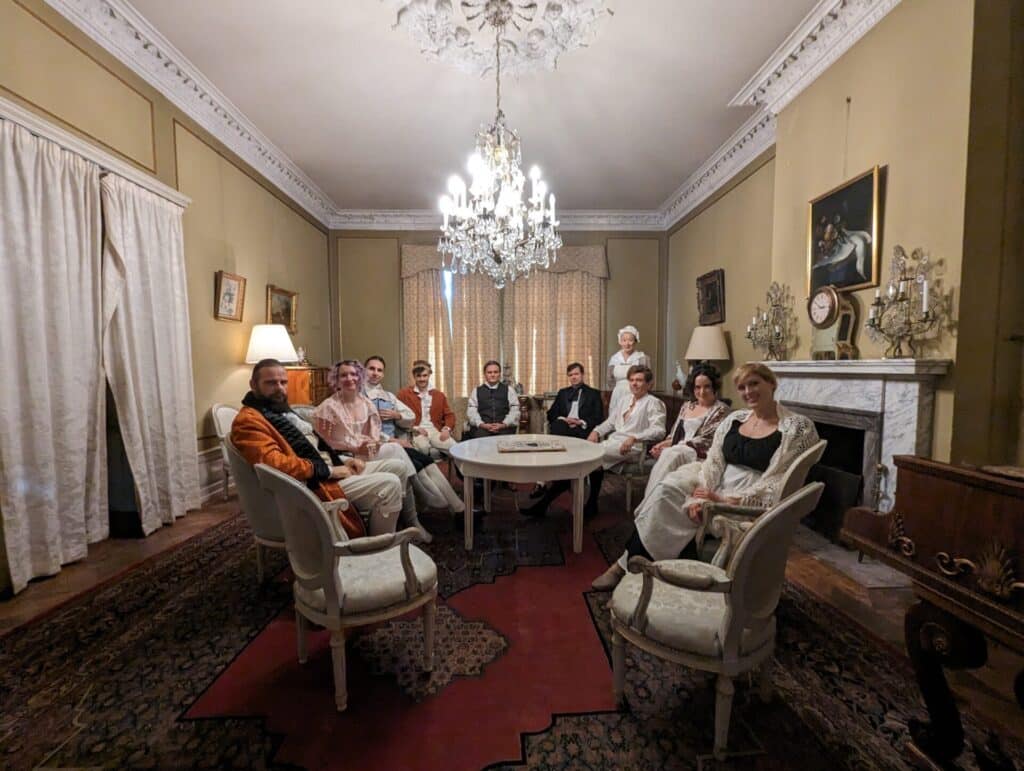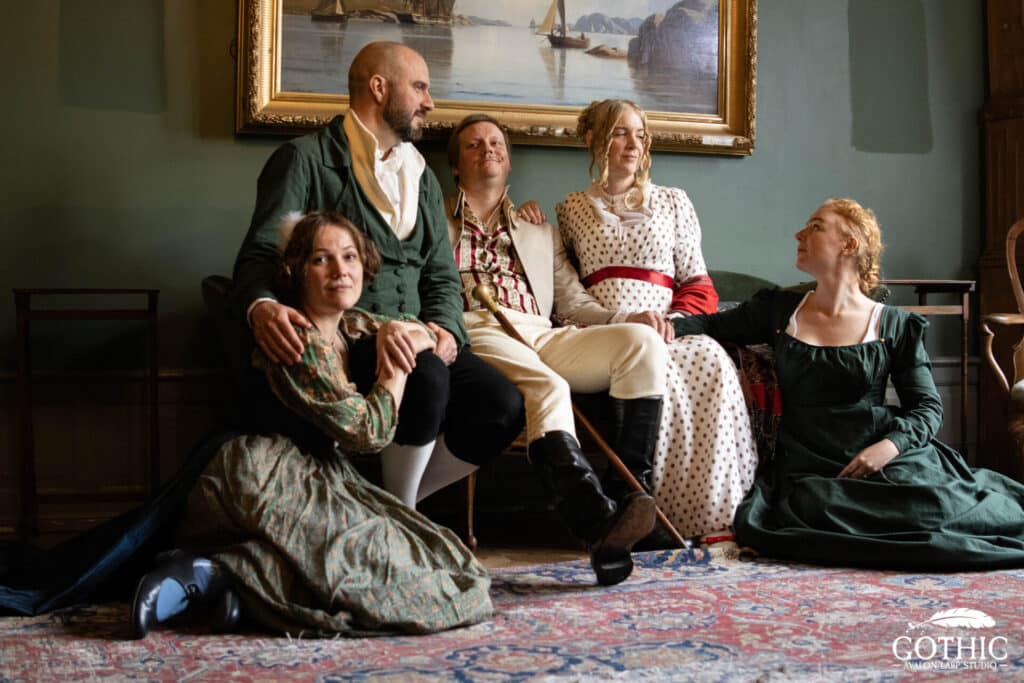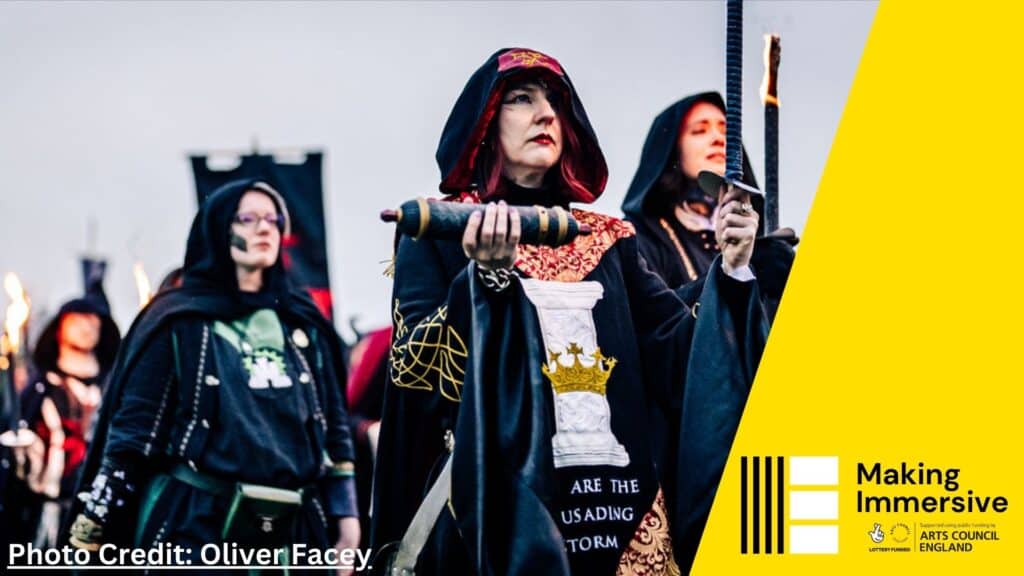Joining a larp for the first time
So, you’re an experienced live immersive experience professional, and you’ve heard that larps are similar to interactive theatre and wondered whether you should get involved with those as well.
Larps (live action role-play events) have some important differences to interactive theatre, though there’s certainly crossover in the skills expected of an event organiser and the modes of interaction available for a participant. You might consider larps as at the far end of a continuum of interactivity: film to theatre to immersive theatre to interactive theatre to larp. Larps are high on participation and co-creation, and low on authorial control over each aspect of the production.
Larps in the UK can vary from live-action versions of Dungeons & Dragons, complete with foam swords so that participants can simulate “live” combat safely; to much more arty, high-concept theatrical events that may be described as “freeforms” or “Nordic larps”. A freeform larp (also called freeform role-play) usually lasts a few hours and would not expect participants to show up in character-appropriate costumes. They might put players in the roles of members of a village community in middle England who perceive their rural traditions are threatened by modern life (Preserving the VIllage by Arnold, Civiera, Holkar, Lee, Minett, and Rider-Hill); or 1960s pirate radio enthusiasts conniving and plotting to ensure their favourite band wins an award (The Day the Music Died by Ashby, Banks, Elsmore, Kaye, and Young). A Nordic style larp usually is longer and can last a weekend. These tend to be preceded by mandatory workshops where participants learn rules and interactive options (“metatechniques”) to better work as an ensemble. Nordic style larps run the gamut from the erotic, psychological horror of being 19th century poets (Gothic by Avalon Larp Studios) to exploration of the impact of HIV-AIDS on the New York gay scene (Just a Little Lovin’ by Grasmo and Edland).
In all larps there’s an expectation of a high level of participation and interactivity. Larp “customers” are active players, not audience members. They want to feel like they can make a difference to how a story unfolds, including influencing how the climax plays. On the flipside, they are also putting more time and effort into preparation. As a player, you shouldn’t expect the larp to handhold you: you will need to do some problem-solving, conflict resolution, and other work, to get the most out of your game.
Usually, when going to a larp, participants sign up after reading the website, pay a fee, read contextualizing material (this can be anything from a few pages to over a hundred pages), read or create their own character, put together a costume (or several) for the character, learn the rules, and show up on site on time. There may also be pre-larp workshops or discussions between players’ groups. While the designers of the larp have control over the setting, the themes, the rules, and the practical arrangements (like the time table), players have strong agency through their characters and within the rules of the larp.
Usually, in a larp, you get what you put in. Going in with a customer mentality, expecting to be entertained, is not a winning strategy. A good larp experience rests on a foundation of participation and personal investments – and the ownership one thus gains over one’s own experience.
Larp designers and organisers need to master expectation management: since there are numerous different larp cultures, styles, and traditions, it is key to communicate ahead of time what a larp is about, what can be done at a larp (i.e. what are the actions available for the players), and what is expected of the players. Furthermore, organisers need to maintain flexibility: they are there to ensure the players enjoy themselves and have a meaningful experience, not to impose their version of the event. The larp designers can and do set the themes and narrative they want the participants to explore, but this is done one step removed, through game design, player briefs and character design, while leaving the final resolution of those questions, and their meaning, to player action. As larp designer Juhana Pettersson has observed, a larp isn’t alive until players have done something the designers did not foresee.
Furthermore, it is good to know that most larps in the UK are not run at a profit. They rely on volunteer labour, created by the community for the community. This means the crew comprises of volunteers, not trained actors. The aesthetic ideals are also different; theatre is often about performative excellence, showing something requiring great skill, vision, and preparation. It is beautiful to see. Larp, on the other hand, is often more about being beautiful to do. The beauty is in inhabiting a fully realized world, together with others.
You should aim to attend an existing larp or two as a player, or perhaps crew member, before organising your own. For a first larp, consider a live-combat grassroots game at your nearest branch of Fools and Heroes, where you’ll be given plenty of guidance and probably loaned a sword by the organiser. If you’re more interested in freeforms or Nordic larps, try The Smoke, where you can try several games in a day, each run by internationally renowned organisers. For a full fantasy experience, do try to get along to Empire. It has intricate design with a functional economy, and a complex political and religious system. Events last a weekend, so in addition to a costume, you’ll need a tent.
Further reading:
James Lórien MacDonald: “Collaborating with Theatre and other Arts”, in Koljonen, Johanna, Stenros, Jaakko, Grove, Anne Serup, Skjønsfjell, Aina D. and Nilsen, Elin (Eds.) (2019): Larp Design. Creating role-play experiences.
Hilda Levin: Nordic larp as postdramatic theatre. Knutpunkt 2018Jaakko Stenros and James Lórien MacDonald: Beauty in Larp. In Eleanor Saitta, Johanna Koljonen, Jukka Särkijärvi, Anne Serup Grove, Pauliina Männistö, & Mia Makkonen (eds.). What Do We Do When We Play?









